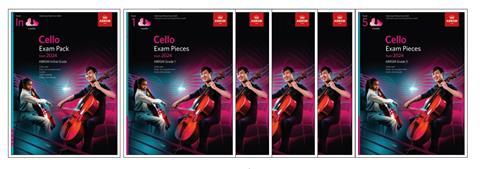Janet Banks reviews the new syllabus for the Associated Board’s cello exams, from Grades 1 to 5

ABRSM Cello Exam Pieces from 2024
Cello part, piano accompaniment & audio
Initial Grade: £9.50
Grade 1: £17.50
Grade 2: £19.50
Grade 3: £21
Grade 4: £23
Grade 5: £28
In its new cello syllabus, for use in exams from January 2024, it is good to see that the ABRSM has a bigger choice of pieces than ever, with more cello duets and pieces by new composers and greater diversity of styles. Before 2020 candidates had just six pieces to choose from in each of the three lists. No books of exam pieces were published for cello; however, all the pieces in the syllabus were available on CD, giving them equal prominence.
The first Cello Exam Pieces books (for grades 1–5 only) were introduced in 2020, with three pieces from each list selected for inclusion, and audio versions of these pieces available from the online shop. The number of pieces on the syllabus increased to ten in each list, to bring it more in line with other exam boards.
The 2024 syllabus has increased still further to 13 pieces in each list, many from previous syllabuses and from popular compilations such as the ABRSM Time Pieces series, and, in the lower grades, Boosey & Hawkes’s Stepping Stones series and OUP’s Cello Time books. However, as in 2020, the only audio versions available (in cello and piano and piano only versions for each piece) are for the nine pieces selected for the books.
A welcome innovation for 2024 is the option in grades 1–3 to play more of the pieces as cello duets with your teacher – there are nine opportunities to do this in Grade 1 alone, although none in the Exam Pieces books, all of which come with piano accompaniment books included.
Also new is the fact that the small-print paragraphs at the bottom of the pieces now give useful performance suggestions – ‘smile through your instrument as you fly up to fourth position’, the Grade 2 pupil is told, perhaps rather optimistically.
Introduced in 2020, the Initial Grade is a marked pre-Grade 1 exam, and comes with a particularly comprehensive book including scales and sightreading. There are some charming new pieces for 2024, including Ladybird Laze by young composer Jemima Oosthuizen, to be played as if ‘snoring in the sunshine’, and Bob Dylan’s Blowin’ in the Wind.
Other popular works included for the first time in grades 1-5 are a natty Supercalifragilisticexpialidocious in C major (Grade 1), Leonard Cohen’s Hallelujah (Grade 2), Hans Zimmer’s ‘He’s a Pirate’ from Pirates of the Caribbean (quite challenging rhythmically for Grade 3, but still likely to prove a hit) and ‘America’ from West Side Story (Grade 4).
Each book includes at least one piece by a female composer. I particularly liked Florence Price’s Rabbit Foot for Grade 3 (though confusingly the recording does not follow the given bowing, slurring groups of semiquavers marked separately) and Norwegian Anna Lindeman’s sunny Tusenfryd (Waltz). Classical favourites also get a look in at Grade 5, with the Waltz from Tchaikovsky’s Sleeping Beauty and Dvořák’s Humoreske, and there’s the usual nod to world music with the traditional Zulu Siyahamba (Grade 1) and The Chengdu Hibiscus by Shanti Jayasinha (Grade 4). It is good to see Bartók appearing in the early grades, with Baking Song (Grade 1) and The Girls of Kis-Szele and The Song of the Drunkard (Grade 3), but in terms of music from the past century, there is not much that is harmonically more adventurous.
JANET BANKS










































No comments yet